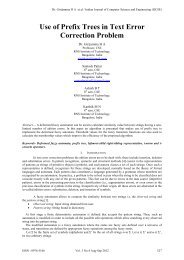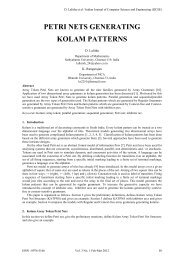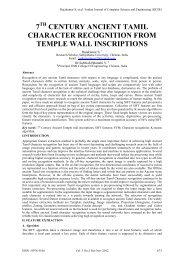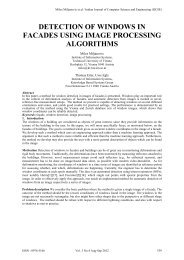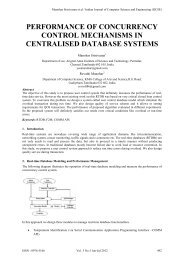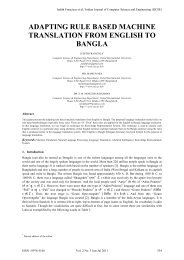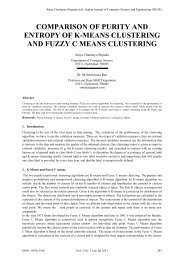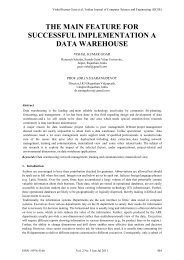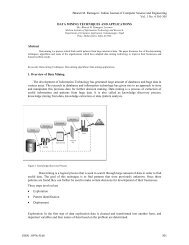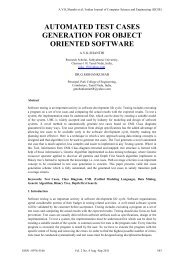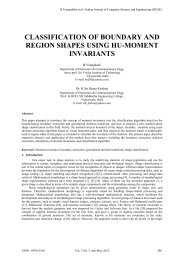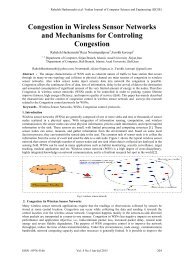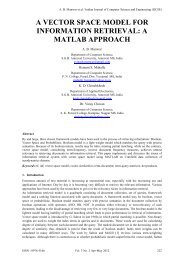Krisna Kant Gautam et al./ Indian Journal of Computer Science and Eng<strong>in</strong>eer<strong>in</strong>g (IJCSE)concisely, and sometimes very curtly, us<strong>in</strong>g rule clauses. A natural language <strong>in</strong>terface will help improve thissituation, but that's not the ma<strong>in</strong> problem. A more important issue is that often users have difficulty <strong>in</strong> "buy<strong>in</strong>g"the output decision. They question it or perhaps don't believe it. Users frequently want to know how the expert<strong>system</strong> arrived at that answer. Most of the better expert <strong>system</strong>s have a means for expla<strong>in</strong><strong>in</strong>g their conclusion.Typically, this takes the form of show<strong>in</strong>g the rules <strong>in</strong>volved <strong>in</strong> the decision and the sequence <strong>in</strong> which they werefired. All of the <strong>in</strong>formation is reta<strong>in</strong>ed <strong>in</strong> the data base for that purpose. When users want to know the expert<strong>system</strong>'s l<strong>in</strong>e of reason<strong>in</strong>g, they can read the rules and follow the <strong>logic</strong> themselves. Some rule formats permit the<strong>in</strong>clusion of an explanation statement that justifies or elaborates on the need for or importance of the rule. Theexplanation facility is important because it helps the user feel comfortable with the outcome. Sometimes theoutcome is a surprise or somewhat different than expected. It is difficult for an <strong>in</strong>dividual to follow the advice ofthe expert <strong>in</strong> these cases. However, once the expert <strong>system</strong> expla<strong>in</strong>s itself, the user better understands thedecision and feels more at ease <strong>in</strong> mak<strong>in</strong>g a decision based upon it.1.2 Ease of ModificationAs <strong>in</strong>dicated earlier, the <strong>in</strong>tegrity of the knowledge base depends upon how accurate and up to date it is. Indoma<strong>in</strong>s where rapid changes take place, it is important that some means be provided for quickly and easily<strong>in</strong>corporat<strong>in</strong>g this knowledge. When the expert <strong>system</strong> was developed us<strong>in</strong>g one of the newer developmenttools, it is usually a simple matter to modify the knowledge base by writ<strong>in</strong>g new rules, modify<strong>in</strong>g exist<strong>in</strong>g rules,or remov<strong>in</strong>g rules. The better <strong>system</strong>s have special software sub<strong>system</strong>s which allow these changes to be madewithout difficulty. If the <strong>system</strong> has been programmed <strong>in</strong> LISP or Prolog, changes are much more difficult tomake. In exam<strong>in</strong><strong>in</strong>g or evaluat<strong>in</strong>g an expert <strong>system</strong>, this feature should be considered seriously <strong>in</strong> context of themodification.1.3 TransportabilityThe wider the availability of an expert <strong>system</strong> the more useful the <strong>system</strong> will be. An expert <strong>system</strong> is usuallydesigned to operate on one particular type of computer, and this is usually dictated by the software developmenttools used to create the expert <strong>system</strong>. If the expert <strong>system</strong> will operate on only one type of computer, itspotential exposure is reduced. The more different types of computers for which the expert <strong>system</strong> is available,the more widely the expertise can be used. If possible, when the expert <strong>system</strong> is to be developed, it should bedone <strong>in</strong> such a way that it is readily transportable to different types of mach<strong>in</strong>es. This may mean choos<strong>in</strong>g aprogramm<strong>in</strong>g language or software development tool that is available on more than one target mach<strong>in</strong>e.1.3 Adaptive Learn<strong>in</strong>g AbilityThis is an advanced feature of some expert <strong>system</strong>s that allows them to learn their own use or experience. As theexpert <strong>system</strong> is be<strong>in</strong>g operated, the eng<strong>in</strong>e will draw conclusions that can, <strong>in</strong> fact, produce new knowledge.New functions stored temporarily <strong>in</strong> the data base, but <strong>in</strong> some <strong>system</strong>s they can lead to the development of anew rule which can be stored <strong>in</strong> the knowledge base and used aga<strong>in</strong> <strong>in</strong> the problem. The more the <strong>system</strong> isused, the more it learns about the doma<strong>in</strong> and more valuable it becomes. The term learn<strong>in</strong>g as applied to expert<strong>system</strong>s refers to the process of the expert <strong>system</strong> new th<strong>in</strong>gs by add<strong>in</strong>g additional rules or modify<strong>in</strong>g exist<strong>in</strong>grules. On the other hand, if the <strong>system</strong> <strong>in</strong>corporates the ability to learn it becomes a much more <strong>power</strong>ful andeffective problem solver. Today few expert <strong>system</strong>s have this capability, but it is a feature that is sure to befurther developed <strong>in</strong>to future <strong>system</strong>s.2. Expert System ApplicationsExpert <strong>system</strong>s are ideal when it is necessary for an <strong>in</strong>dividual to select the best alternative from a long list ofchoices. Based on the criteria supplied to it, the expert <strong>system</strong> can choose the best option. In <strong>power</strong> <strong>system</strong>s,many promis<strong>in</strong>g <strong>application</strong>s have been reported <strong>in</strong> the broad field of <strong>system</strong> control, alarm process<strong>in</strong>g and <strong>fault</strong><strong>diagnosis</strong>, <strong>system</strong> monitor<strong>in</strong>g, decision support, <strong>system</strong> analysis and plann<strong>in</strong>g. An excellent review of thepopular <strong>application</strong> areas can be found <strong>in</strong> [1].3.Reason<strong>in</strong>g with Uncerta<strong>in</strong>ty <strong>in</strong> Rule Based Expert SystemsOne of the important feature <strong>in</strong> expert <strong>system</strong>s is their ability to deal with <strong>in</strong>correct or uncerta<strong>in</strong> <strong>in</strong>formation.Traditional algorithmic software simply cannot deal with <strong>in</strong>complete <strong>in</strong>formation. If the data is <strong>in</strong>correct, theanswer will be <strong>in</strong>correct. This is where artificial <strong>in</strong>telligence programs, particularly expert <strong>system</strong>s, areparticularly useful. When the <strong>in</strong>puts are ambiguous or completely miss<strong>in</strong>g, the program may still f<strong>in</strong>d a solutionto problem. The <strong>system</strong> may qualify that solution, but at least it is an answer that can <strong>in</strong> many cases be put topractical use. Thus, <strong>in</strong> the design of expert <strong>system</strong>s, there has been a focus on methods of obta<strong>in</strong><strong>in</strong>g approximatesolutions to a problem when there is no clear conclusion from the given data. Logically, as expert <strong>system</strong>problems become more complex, the difficulty of reach<strong>in</strong>g a conclusion with complete certa<strong>in</strong>ty <strong>in</strong>creases, so <strong>in</strong>some cases, there must be a method of hand<strong>in</strong>g uncerta<strong>in</strong>ty. In [2,3], researchers have reported that a classicalISSN : 0976-5166 Vol. 2 No. 4 Aug -Sep 2011 555
Krisna Kant Gautam et al./ Indian Journal of Computer Science and Eng<strong>in</strong>eer<strong>in</strong>g (IJCSE)expert <strong>system</strong> gave <strong>in</strong>correct results due to the sharpness of the boundaries created by the if-then rules of the<strong>system</strong>; however, once a method for deal<strong>in</strong>g with uncerta<strong>in</strong>ty (<strong>in</strong> these two cases <strong>fuzzy</strong> set theory) was used,the expert <strong>system</strong> reached the desired conclusions. The expert knowledge takes the form of heuristics,procedural rules and strategies <strong>in</strong> nature. It <strong>in</strong>herently conta<strong>in</strong>s vagueness and imprecision. Uncerta<strong>in</strong>ty <strong>in</strong> rulebased expert <strong>system</strong>s occurs <strong>in</strong> two forms. The first form is l<strong>in</strong>guistic uncerta<strong>in</strong>ty which occurs if an antecedentconta<strong>in</strong>s vague statements such as the level is high" or "the value is near 20". The other form of uncerta<strong>in</strong>ty,called evidential uncerta<strong>in</strong>ty, occurs if the relationship between an observation and a conclusion is not entirelycerta<strong>in</strong>. This type of uncerta<strong>in</strong>ty is most commonly handled us<strong>in</strong>g conditional probability which <strong>in</strong>dicates thelikelihood that a particular observation leads to a specific conclusion. The study of mak<strong>in</strong>g decisions undereither of these types of uncerta<strong>in</strong>ty will be referred to as plausible or approximate reason<strong>in</strong>g <strong>in</strong> this work.Several methods of deal<strong>in</strong>g with uncerta<strong>in</strong>ty <strong>in</strong> expert <strong>system</strong>s have been proposed, <strong>in</strong>clud<strong>in</strong>gSubjective probabilityCerta<strong>in</strong>ty factorsFuzzy measuresFuzzy set theoryThe first three methods are generally used to handle evidential uncerta<strong>in</strong>ty, while the last method, <strong>fuzzy</strong> settheory is used to <strong>in</strong>corporate l<strong>in</strong>guistic uncerta<strong>in</strong>ty. [4]. As expert assessments of the <strong>in</strong>dicators of the problemmay be imprecise, <strong>fuzzy</strong> sets may be used for determ<strong>in</strong><strong>in</strong>g the degree to which a rule from the expert <strong>system</strong>applies to the data that is analyzed.4.Fuzzy LogicAnother method of deal<strong>in</strong>g with imprecise or uncerta<strong>in</strong> knowledge is to use <strong>fuzzy</strong> <strong>logic</strong>. Fuzzy <strong>logic</strong> is a <strong>system</strong>conceived by Zadeh for deal<strong>in</strong>g <strong>in</strong> <strong>in</strong>exact or unreliable <strong>in</strong>formation. In this method, an attempt is made toassign numerical ranges with a possibility value between zero and one to concepts and elements with values thatare hard to p<strong>in</strong> down. It allows you to work with ambiguous or <strong>fuzzy</strong> quantities such as large or small, or datathat is subject to <strong>in</strong>terpretation.FIG 1. Fuzzy Sets for representation of uncerta<strong>in</strong>ity5. Fault DiagnosisIn the past few years, great emphasis has been put <strong>in</strong> apply<strong>in</strong>g the expert <strong>system</strong>s for transmission <strong>system</strong> <strong>fault</strong><strong>diagnosis</strong>. However, very few papers deal with the unavoidable uncerta<strong>in</strong>ties that occur dur<strong>in</strong>g operation<strong>in</strong>volv<strong>in</strong>g the <strong>fault</strong> location and other available <strong>in</strong>formation. This paper shows a method us<strong>in</strong>g <strong>fuzzy</strong> sets to copewith such uncerta<strong>in</strong>ties.5.1 Problem StatementTo reduce the outage time and enhance service reliability, it is essential for dispatchers to locate <strong>fault</strong> sections <strong>in</strong>a <strong>power</strong> <strong>system</strong> as soon as possible. Currently, heuristic rules from dispatchers’ past experiences are extensivelyused <strong>in</strong> <strong>fault</strong> <strong>diagnosis</strong>. The important role of such experience has motivated extensive recent work [5-11] on the<strong>application</strong> of expert <strong>system</strong> <strong>in</strong> this field. A few papers have described and dealt with uncerta<strong>in</strong>ties <strong>in</strong>volv<strong>in</strong>g the<strong>fault</strong> location and other <strong>in</strong>formation available [12-15]. These uncerta<strong>in</strong>ties occur due to failures of protectiverelays and breakers, errors of local acquisition and transmission, and <strong>in</strong>accurate occurrence time, etc. Aneffective approach is thus necessary to deal with uncerta<strong>in</strong>ties <strong>in</strong> these expert <strong>system</strong>s. Fault <strong>diagnosis</strong> <strong>in</strong> electric<strong>power</strong> <strong>system</strong> is a facet operation. Every signal and step conta<strong>in</strong> some uncerta<strong>in</strong>ties, which can be modeled bymembership functions. Fuzzy set theory is used to determ<strong>in</strong>e the most likely <strong>fault</strong> sections <strong>in</strong> the approachpresented here. Membership functions of the possible <strong>fault</strong> sections are the most important factors <strong>in</strong> the<strong>in</strong>ference procedures and decision mak<strong>in</strong>g. In this example, the membership function of a hypothesis is used todescribe the extent to which the available <strong>in</strong>formation and the <strong>system</strong> knowledge match the hypothesis. They aremanipulated dur<strong>in</strong>g <strong>in</strong>ference based on rules concern<strong>in</strong>g <strong>fault</strong> sections.ISSN : 0976-5166 Vol. 2 No. 4 Aug -Sep 2011 556



